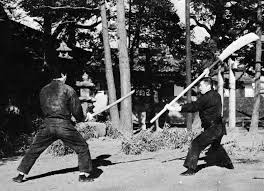Naginata, Bujinkan Halberd Fighting. The techniques of Naginata-jutsu and Bisentō-jutsu as well as other long bladed pole arms from the Kukishin-ryu.
秘薙刀 NAGINATA
The origin of the Naginata, Bisentō, Nagamaki is a variation of the Chinese Guandao. People from China fled to the mountains in the Iga region during the fall of the Tang Dynasty (618–907 CE) and brought along their warfare techniques. They settled in the region and passed on their knowledge to the local people.
The term 薙刀 Naginata (halberd), can also be written with the Japanese characters 長刀 Naginata (long blade), and that meaning also includes the Bisentō. Additionally, if you write 薙鉈 Naginata, meaning “to mow down” and “wide-bladed knife,” it will hone your way of thinking until you see it as fighter’s tool. When expressing this through the Nine-demon Kami School of Kukishin-ryu, the nine demons of the Naginata are able to change into enormous monsters, mutating into a large hatchet, a huge axe, and the massive Nyoitō, able to strike down upon and crush even the most impregnable iron shields and helmets, becoming the secret enlightened blade of the 秘閃刀 Bisentō (hidden flash sword).
– The Essence of Budo by Masaaki Hatsumi
構えKAMAE: (Postures)
1. 八相之構 HASSŌ NO KAMAE
2. 青眼之構 SEIGAN NO KAMAE
3. 横一文字之構 YOKOICHIMONJI NO KAMAE
4. 中青眼之構 NAKASEIGAN NO KAMAE
5. 平一文字之構 HIRAICHIMONJI NO KAMAE
秘薙刀術型 BI-NAGINATA-JUTSU KATA: (Patterns)
1. 薙倒 NAGI-TAOSHI
2. 掬上 SUKUI-AGE
3. 拔倒 BATTŌ
4. 足拂 ASHI-BARAI
5. 撥倒 HATTŌ
6. 繰出 KURI-DASHI
7. 前後薙 ZENGO-NAGI
8. 差違 SASHI-CHIGAI
9. 飛切 TOBI-KIRI
眉尖刀術型 BISENTŌ-JUTSU KATA: (Patterns)
In the first year of the Hogen era (1156), Izumo no Kanja Yoshiteru, who was of the original line of the Genji clan, bailed against a powerful rival and regent to the emperor, Taira no Tadamichi. After the Genji clan was defeated, Yoshiteru was forced to escape and chose to flee to the Inome cavern at Izumo. It just so happened that a monk named Tetsujo had escaped from Tang China and was also inhabiting that particular cavern. This monk was a warrior, a true master of the military arts of Tang China. And so Yoshiteru learned all the methods of combat that the monk had to teach. It is said that this is where Yoshiteru learned the Bisentō.
– The Essence of Budo by Masaaki Hatsumi
1. 汪振 ŌSHIN (Deep Wave)
2. 鬲逆 KAKUGYAKU (Tripod Reversal)
3. 竹斜 CHIKUSHA (Leaning Bamboo)
4. 波刃 NAMIBA (Wave Edge)
5. 抜刀 BATTŌ (Drawing Blade)
6. 㬢先 GISEN (Before the Light of Day)
7. 伸刀 SHINTŌ (Lengthening Sword)
8. 惺刀 SEITŌ (Tranquil Sword)
9. 魅剣 MIKEN (Demon Sword)
